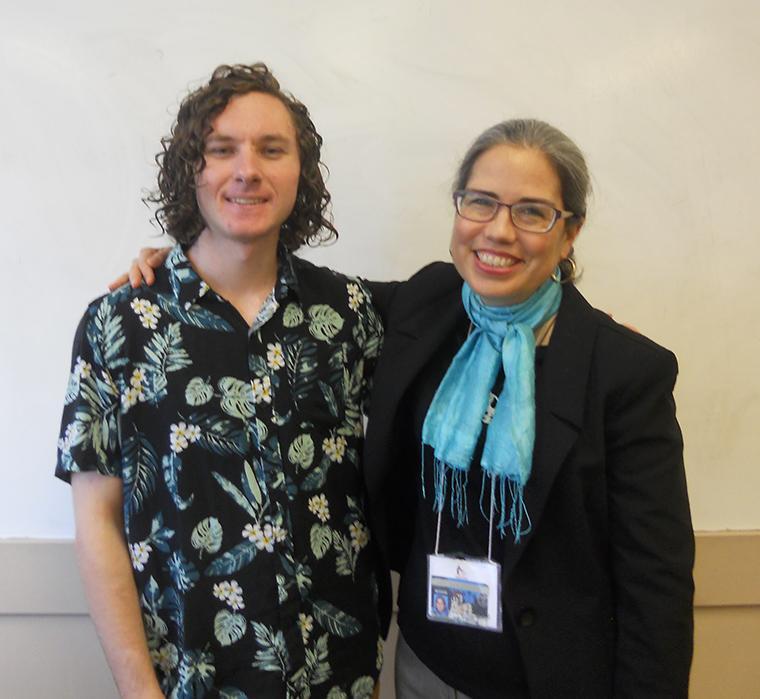
Religious Studies Major Cameron Heon and Faculty Member Sarita Tamayo-Moraga Present at AARWR
On March 25, 2018, sophomore Cameron Heon (major in Religious Studies ‘20) and Sarita Tamayo-Moraga (Senior Lecturer in Religious Studies) gave a presentation at the American Academy of Religion Western Region (AARWR) conference in Berkeley, CA on the pedagogy of the RSOC 9: Ways of Understanding Religion class that is linked to the Imagine interfaith/belief floor in Unity Residential Learning Community and to Campus Ministry. The paper was entitled “Pedagogical Practices for Turning Reactivity and Rigidity into Empathy, Stability, and Flexibility in a First Year Religious Studies Course” and was included in the Pedagogy of Religious Studies Unit of the AARWR. The theme of the conference was “Does kindness, especially as ‘a core dimension of religion’ show up in our courses?” The argument of our paper was that kindness is in fact a core aspect of a transformative, flexible, non-reactive pedagogy.
A Brief Report from Sarita
Academic year 2017-2018 was the third year of the Imagine Interfaith/belief RSOC 9. Cameron was in the second incarnation of the Imagine RSOC 9 and was peer educator for the third incarnation of the class/community in Fall of 2017. He and I both live in the Unity Residential Learning Community whose theme is diversity as a catalyst for civic engagement. I am the Faculty Director of the hall. The Imagine floor inside the hall consists of the 28 students who take the Fall version of the RSOC 9 class. Thus, we all live together and learn together. What follows is a brief summary of the pedagogy and then an excerpt from Cameron’s personal experience of both the class and the conference.
I began the paper by summarizing key aspects of the pedagogy of the class linked to the cultivation of kindness and stability. Cameron then talked about his real life experience applying the pedagogy both inside and outside the class and then in his own life spontaneously after the class ended. The bridge between my section of the paper and Cameron’s section of the paper was composed of the periodic journal assignment and the service activity that involved cooking for and taking dinner to Muslim refugees at Immanuel House in downtown San Jose. The journal assignment asks students to track their emotional reactivity to the readings in class and to track challenges to one’s worldview, or ‘mask’ that might prevent clarity or understanding.
Through studying and writing journals on emotional responses and/or reactivity to that which is studied in the class or encountered outside the classroom, such as a Muslim refugee or someone experiencing homelessness, students learn how to gain clarity despite strong emotional reactivity. This stability in turn allows them to gain clarity and be patient with themselves and that which they study. Anecdotally, students report that the emotional effect of such learning has been the experience of kindness and empathy. This paper was a first attempt to begin codifying the impact of the pedagogy of the class coupled with the impact of living together and attending interfaith dinners sponsored by Campus Ministry. Thus, the floor is a collaboration between Religious Studies, Housing and Residence Life, and Campus Ministry.
A Brief Report from Cameron on the Pedagogy of the Journals
Through studying and writing journals on Freud and other academic theorists, I was challenged to become more open to Freud’s own worldviews and then change my own enough to be open to that with which I disagree and still learn from theories with which I disagree. By letting my emotions take a back seat, I was able to find aspects of Freud’s arguments that advanced my understanding of religion. At the conference, I elaborated on the above and also discussed the impact of my two year experience with the Imagine floor and the way it changed how I view those who are often stereotyped and misunderstood.
Plans for the Future
Sarita and Cameron plan to try to write an article together on the pedagogy of the class and its impact as the Imagine floor continues into the future. A possible goal is to then present on the pedagogy and the class at the national conference of the American Academy of Religion in the future.